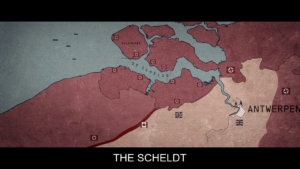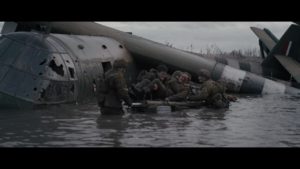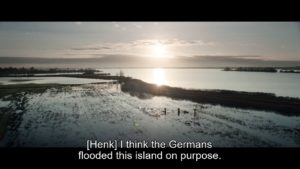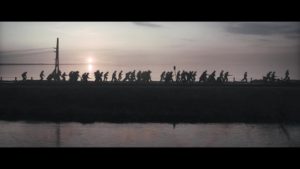The Forgotten Battle – Predictable yet engrossing
The Historical map and background shown at the beginning of the

first few seconds clarify what the film is all about. Simply put, since French ports were still in German hands and being defended resolutely, the only other port, easily captured was Antwerp in Belgium which sat at the end of the long journey from the North Sea via the river Scheldt. The Germans occupied Walcheren and other islands at the entry point on the North Sea, thus making it almost impossible for supplies to reach the advancing Allies who were already in Belgium, occupied Holland and even close to the German frontier.
The film uses this historical background to tell three different stories. Three perspectives. Just like Dunkirk, the three stories intersect at Walcheren Island. The telling of these three stories takes up the time in the film and not so much as the historical battle, which is only partially covered in the final scenes. Naturally, you can’t have a historically different outcome to the events of September – November 1944.
The Dutch Teunte Visser (Susan Redder), her father, doctor Visser (Jan Bijvoet), brother Dirk, and friend Janna are in the Resistance. With the Germans on the retreat in September, there is an atmosphere of hope and even joy. This is soon dashed when reality comes crumbling down to show how much the Germans are still in charge and behaving as ruthlessly as ever.
Glider Pi lot William Sinclair (Jamie Flatter) lies and flies into Operation Market Garden, the airborne invasion. His glider is shot down, and the survivors, including his lead pilot and wounded officer, Tony Turner (Tom Felton), their Dutch colleague Henk (Coen Bril), and two others, try to find their way through the flooded Walcheren Island to safety, dodging German patrols.
lot William Sinclair (Jamie Flatter) lies and flies into Operation Market Garden, the airborne invasion. His glider is shot down, and the survivors, including his lead pilot and wounded officer, Tony Turner (Tom Felton), their Dutch colleague Henk (Coen Bril), and two others, try to find their way through the flooded Walcheren Island to safety, dodging German patrols.
Marinus van Stavern (Gijs Blom) is an ardent anti-Communist Dutchman who has joined the Nazis and is wounded in action in the Eastern Front. Before committing suicide, a German officer pulls some strings to ensure that he is sent back to Holland, and he too lands in Walcheren.
The three lives intersect at the island. Teunte has to get maps of the island to the Allies, that had costed her brother’s lives and the Resistance cell. Marinus is now part of the Army that executes local hostages and is increasingly doubtful whether he is on the right side. After Tony’s death and separation from Henk, Will is alone and gets across the island to be greeted by Canadians.
There is an atmosphere of “every man or woman for himself” – just like Dunkirk. This aspect of the film is absorbing, even though there are more significant events taking place in the background, namely the likely invasion of the beleaguered island.
While the Teunte story is somewhat predictable, it is the group of “lost” paratroopers that repeatedly holds our attention time and again. As one by one, the soldiers start dying, the raw survival instincts take over. Will is constantly faced with situations he had not trained for, though as a glider pilot, he is expected to fight with the fellow soldiers he flew into battle. But when those soldiers are no more, there is only the self to look after. This story is the most interesting one in the entire film and anchors the story. However, it is contrasted with Marinus and his gradual conversion away from the Nazi cause. Though he fights and even executes his fellow countrymen, his doubts are written large on his face. Even when facing the expected assault by the Canadians on the causeway, his doubts persist while serving faithfully as the loader on the machine gun.
into battle. But when those soldiers are no more, there is only the self to look after. This story is the most interesting one in the entire film and anchors the story. However, it is contrasted with Marinus and his gradual conversion away from the Nazi cause. Though he fights and even executes his fellow countrymen, his doubts are written large on his face. Even when facing the expected assault by the Canadians on the causeway, his doubts persist while serving faithfully as the loader on the machine gun.
No doubt, the three characters are fictitious, but they are used as the anchors to tell the story of the battle. Still, the characters, too, have their personal struggles to fight. From being “neutral” and working in the “Mayor’s Office”, Teunte is soon confronted by events beyond her control. Taking a stand soon becomes essential – to be with or away from the small resistance movement on the island.
 The climactic battle of the causeway, which was costly for the attacking Canadians, is well recreated. When you look at the start-up to the assault, your immediate thought is – this is suicide; no cover, a narrow road on which everyone is bunching up, the sea on both sides of the road and easy targets for the defending Germans. That’s precisely what happened in the actual battle. Did we say attention to detail earlier? The only thing missing is the attack from the North Sea by British Commandos – at least that should have been there. As shown in the movie, the attacks from the Causeway and the flanking attack by the Canadians, put paid to the German defences on the Eastern Side of Walcheren, while the COmmandos landed from the sea on the Western side .
The climactic battle of the causeway, which was costly for the attacking Canadians, is well recreated. When you look at the start-up to the assault, your immediate thought is – this is suicide; no cover, a narrow road on which everyone is bunching up, the sea on both sides of the road and easy targets for the defending Germans. That’s precisely what happened in the actual battle. Did we say attention to detail earlier? The only thing missing is the attack from the North Sea by British Commandos – at least that should have been there. As shown in the movie, the attacks from the Causeway and the flanking attack by the Canadians, put paid to the German defences on the Eastern Side of Walcheren, while the COmmandos landed from the sea on the Western side .
For a 2020 film, getting all the Second World War gear correct is undoubtedly a difficult task. However, in many scenes, the accuracy and authenticity are excellent, especially for the small arms. The rip-roar of the German MG34s, the heavy rat a tat of the Brens, the CGI generated Horsa Gliders and the Market Garden Invasion armada, the uniforms and webbing used by both the German and the British – all these shows excellent attention to detail.
The locations in Walcheren and Lithuania need special mention as substitutes for the actual events depicted here.
Overall, an excellent film that uses the historical background to tell three parallel stories that intersect on Walcheren Island and get resolved by the final climactic battle to capture the island.
Real History – 3 out of 5
Equipment and Kit – 5 out of 5
Locations or substitutes – 5 out of 5
Story/ “Hollywood” element – 4 out of 5
Role of women – 4 out of 5
Music – 3 out 5
Overall Rating – 4 out of 5
Excellent . Your eye fir spotting weapons their noise is really classic 👏👏👏